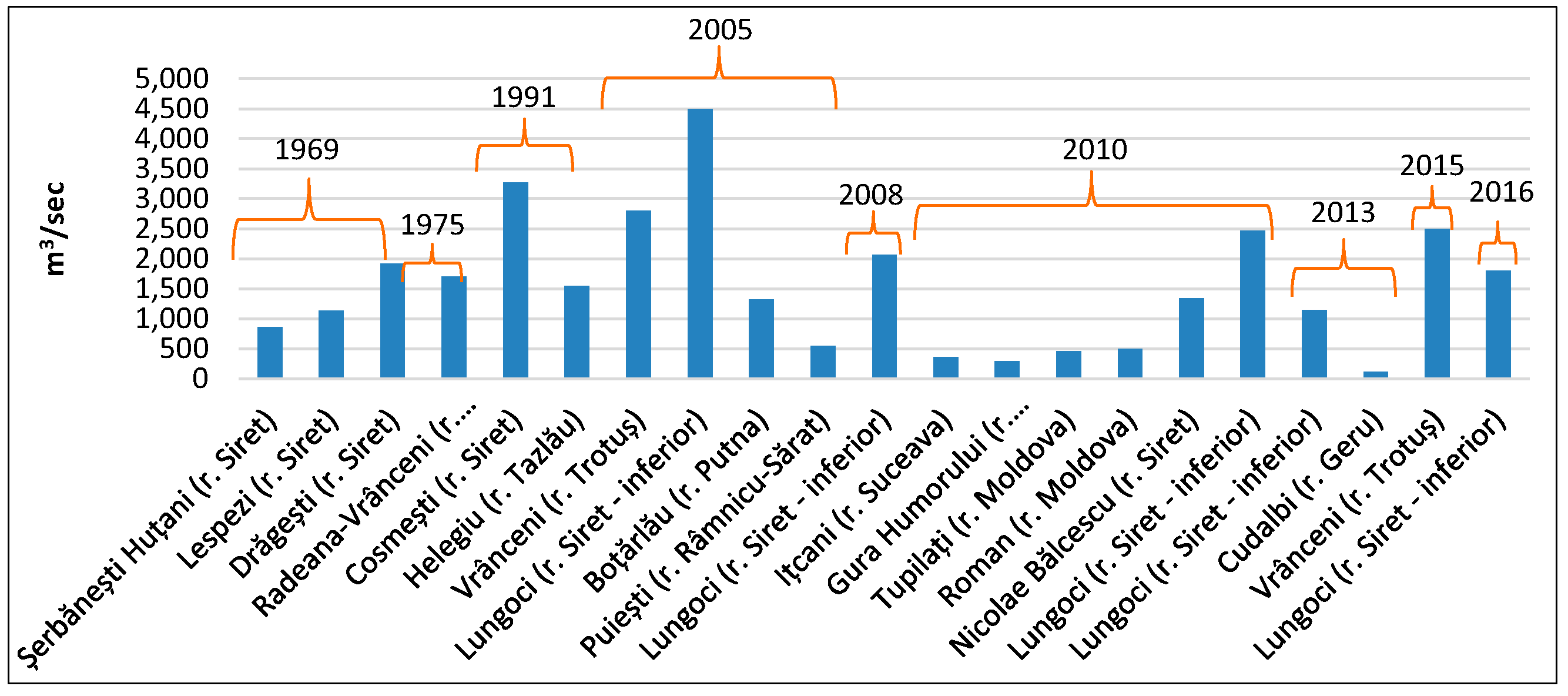Development of Flood Risk and Hazard Maps for the Lower Course of the Siret River, Romania
Abstract
1. Introduction
2. Study Area and Data
2.1. Study Area
2.2. Data
3. Materials and Methods
3.1. Land Surveying and Bathymetry Equipment
3.2. Numerical Simulation
- Depth < 0.5 m—low flood risk: in this case, the flood extent does not present any hazard to the people and has a low impact on the economic and sociocultural life. Moreover, this category of flood risk presents little difficulty in evacuation of habitants.
- 0.5 m < Depth < 1.5 m—medium flood risk: in this case, the flood hazard may affect a region to a greater extent. There may be some difficulties in case of people evacuation, and there may be a medium to high influence on the economic and sociocultural indicators.
- Depth > 1.5 m—high flood risk: this class represents an unwelcome situation where the flood hazard has a very high impact on the people, economy, infrastructure, and environmental and cultural indicators.
4. Results and Discussion
- N10%—flow discharge Q = 2280 m3 s−1; WSEBSC = 773 cm;
- N5%—flow discharge Q = 2850 m3 s−1, WSEBSC = 820 cm;
- N2%—flow discharge Q = 3520 m3 s−1, WSEBSC = 867 cm;
- N1%—flow discharge Q = 4060 m3 s−1, WSEBSC = 906 cm.
5. Conclusions
Author Contributions
Funding
Acknowledgments
Conflicts of Interest
Appendix A
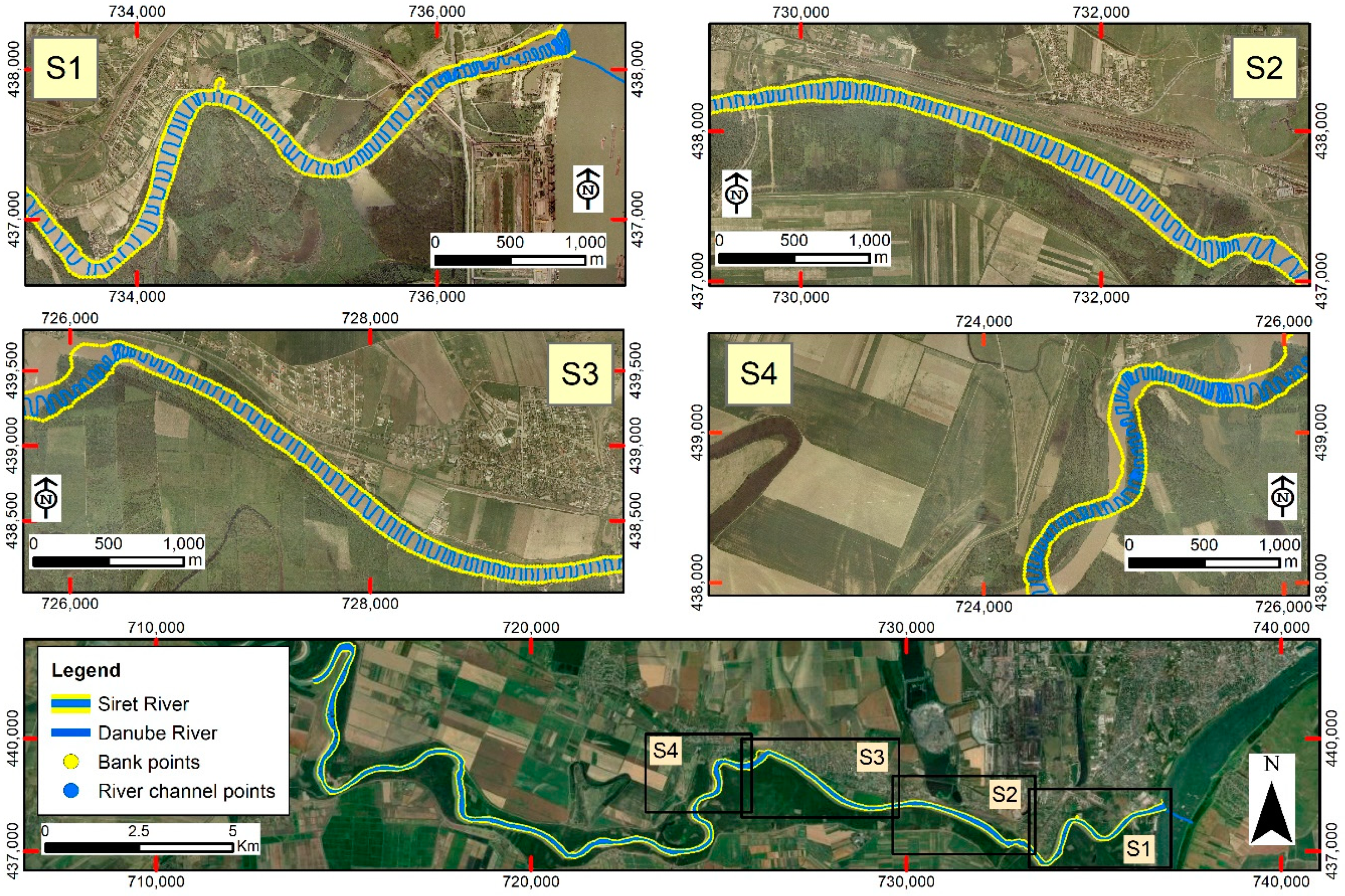
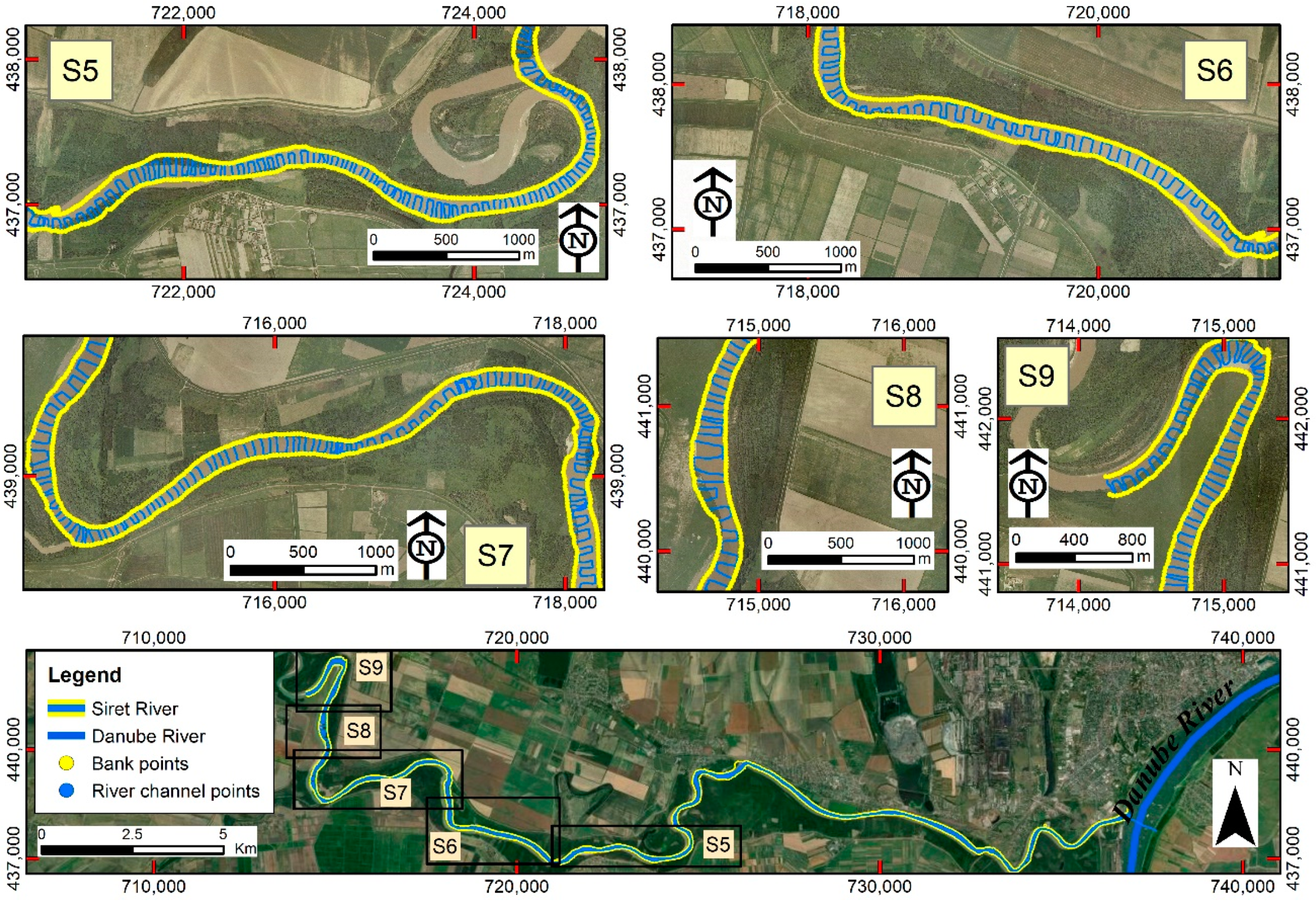
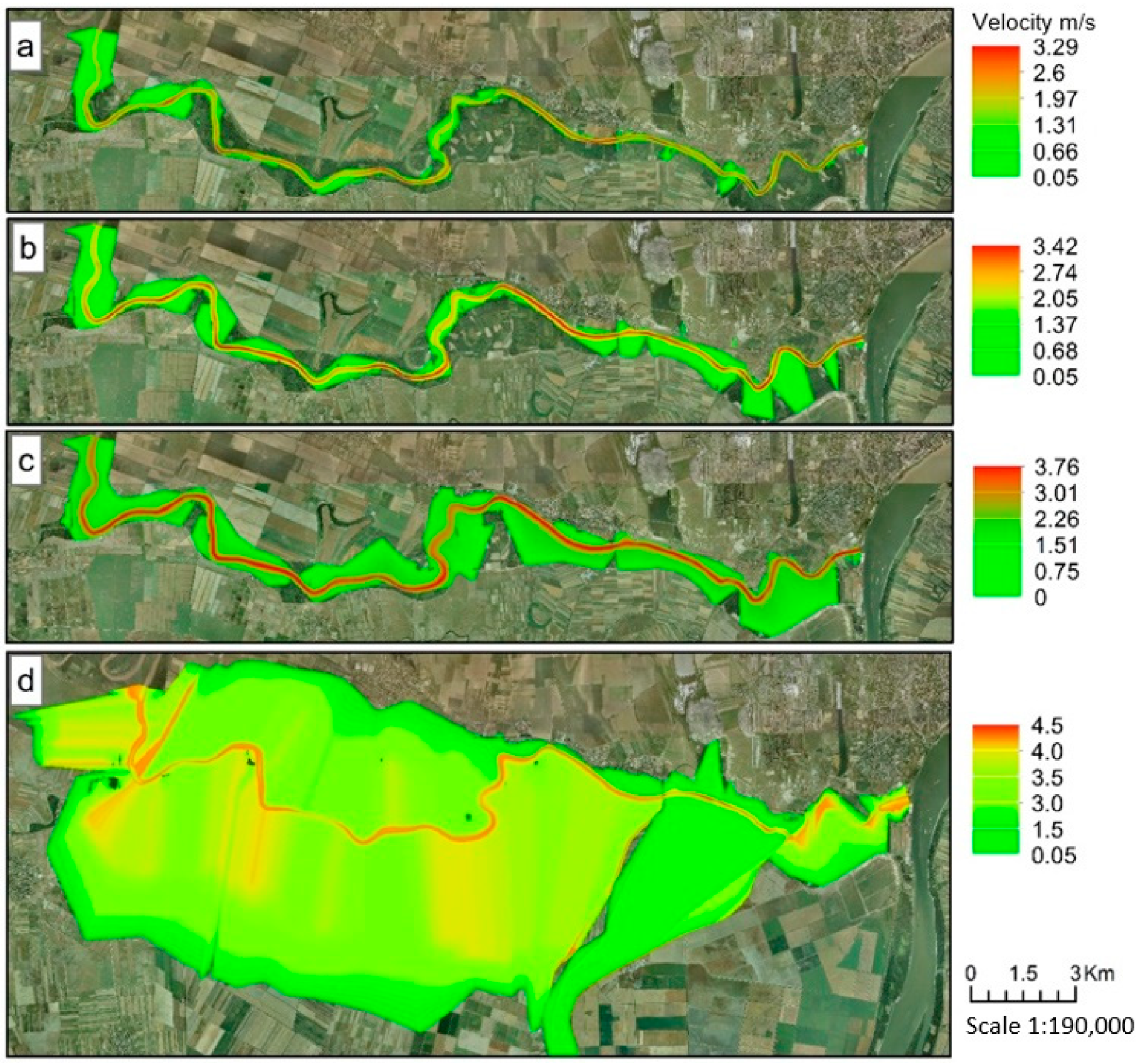
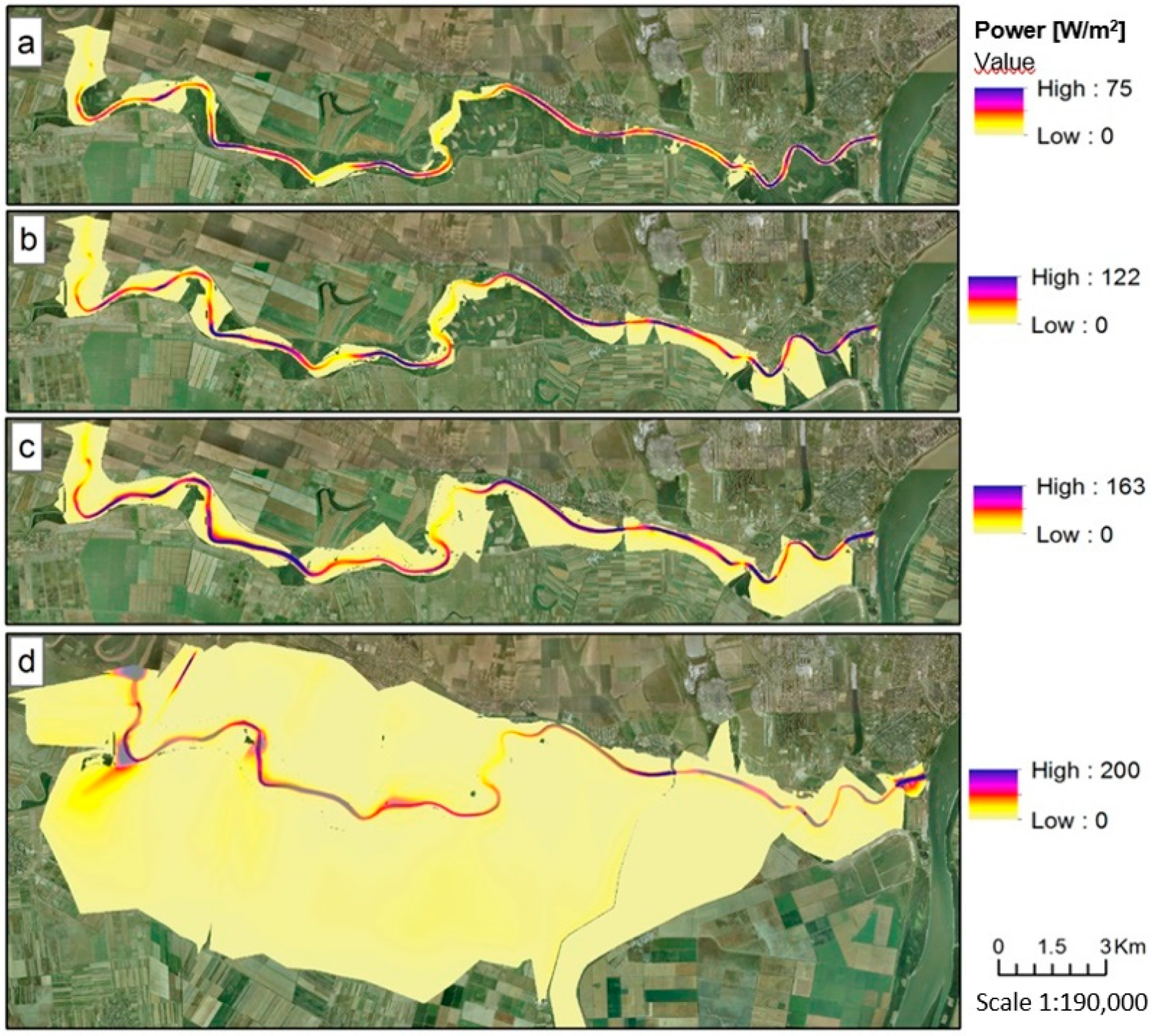
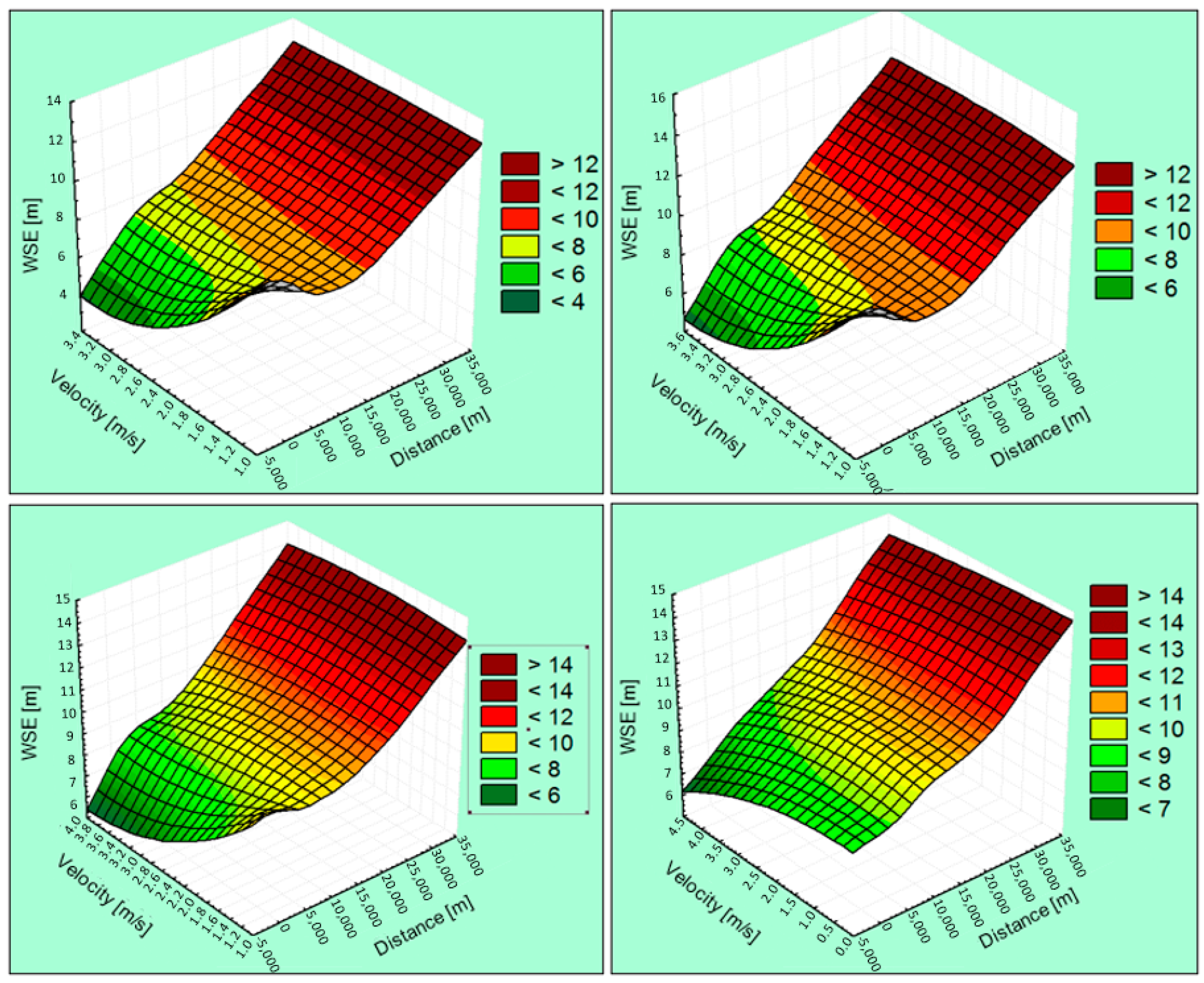
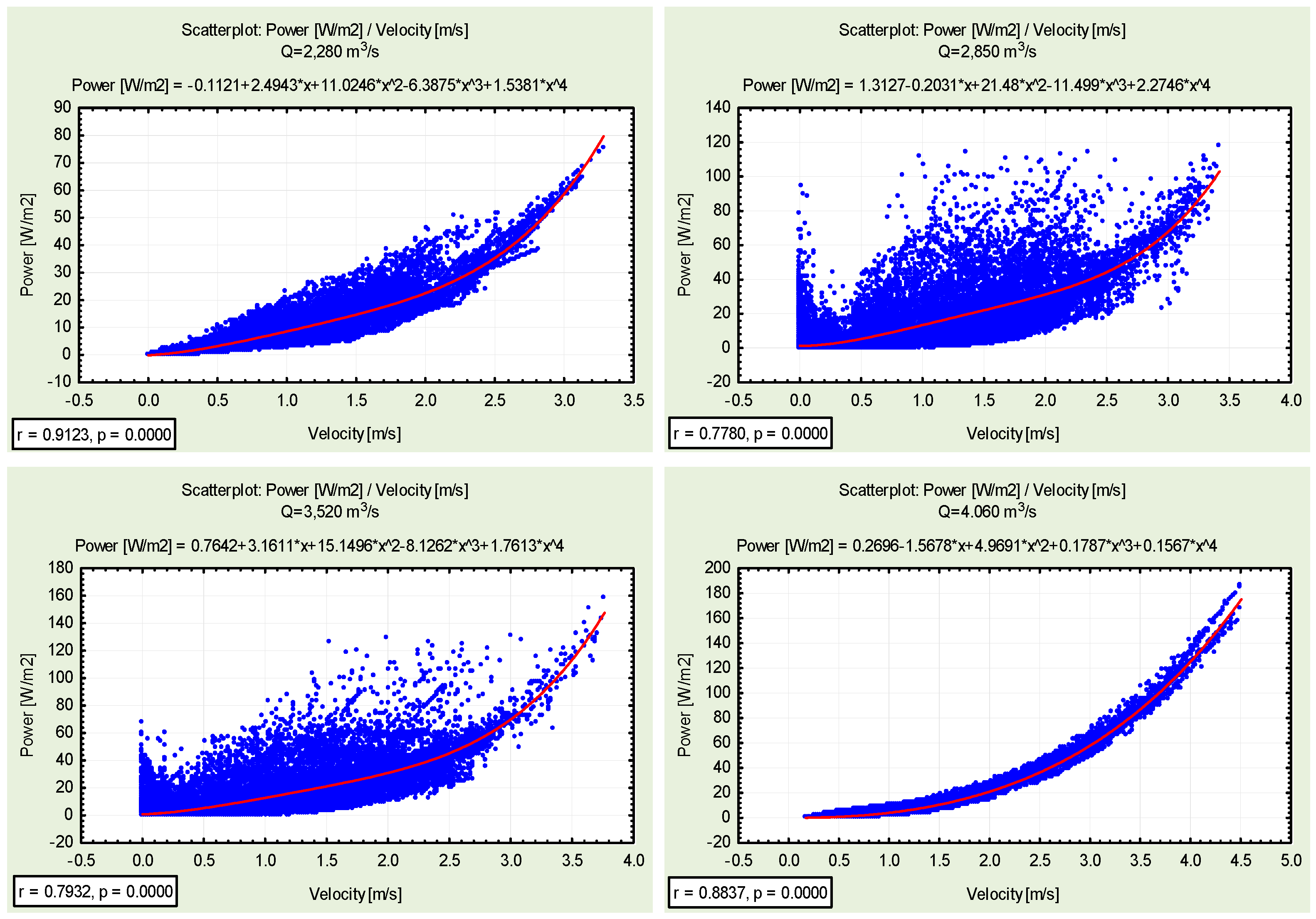
References
- Quirogaa, V.M.; Kurea, S.; Udoa, K.; Manoa, A. Application of 2D numerical simulation for the analysis of the February 2014 Bolivian Amazonia flood: Application of the new HEC-RAS version 5. Ribagua 2016, 3, 25–33. [Google Scholar] [CrossRef]
- Luu, C.; Tran, H.X.; Pham, B.T.; Al-Ansari, N.; Tran, T.Q.; Duong, N.Q.; Dao, N.H.; Nguyen, L.P.; Nguyen, D.H.; Ta, H.T.T.; et al. Framework of Spatial Flood Risk Assessment for a Case Study in Quang Binh Province, Vietnam. Sustainability 2020, 12, 3058. [Google Scholar] [CrossRef]
- Mysiak, J.; Testella, F.; Bonaiuto, M.; Carrus, G.; De Dominicis, S.; Cancellieri, U.G.; Firus, K.; Grifoni, P. Flood risk management in Italy: Challenges and opportunities for the implementation of the EU Floods Directive (2007/60/EC). Nat. Hazards Earth Syst. Sci. 2013, 13, 2883–2890. [Google Scholar] [CrossRef]
- European Environment Agency. Directive 2007/60/EC of the European Parliament and of the Council on the Assessment and Management of Flood Risks. Available online: https://www.eea.europa.eu/policy-documents/directive-2007-60-ec-of (accessed on 20 April 2020).
- Spachinger, K.; Dorner, W.; Metzka, R.; Serrhini, K.; Fuchs, S. Flood Risk and Flood Hazard Maps–Visualisation of Hydrological Risks. IOP Conf. Ser. Earth Environ. Sci. 2008, 4, 012043. [Google Scholar] [CrossRef]
- Lo, S.W.; Wu, J.H.; Lin, F.P.; Hsu, C.H. Visual sensing for urban flood monitoring. Sensors 2015, 15, 20006–20029. [Google Scholar] [CrossRef] [PubMed]
- Murphy, A.T.; Gouldby, B.; Cole, S.J.; Moore, R.J.; Kendall, H. Real-time flood inundation forecasting and mapping for key railway infrastructure: A UK case study. E3S Web Conf. 2016, 7, 18020. [Google Scholar] [CrossRef]
- Van Leeuwen, B.; Tobak, Z.; Kovács, F. Sentinel-1 and -2 Based near Real Time Inland Excess Water Mapping for Optimized Water Management. Sustainability 2020, 12, 2854. [Google Scholar] [CrossRef]
- Domeneghetti, A.; Schumann, G.J.-P.; Tarpanelli, A. Preface: Remote Sensing for Flood Mapping and Monitoring of Flood Dynamics. Remote Sens. 2019, 11, 943. [Google Scholar] [CrossRef]
- Arseni, M.; Roșu, A.; Bocăneală, C.; Constantin, D.-E.; Georgescu, P.L. Flood hazard monitoring using GIS and remote sensing observations. Carpathian J. Earth Environ. Sci. 2017, 12, 329–334. [Google Scholar]
- Abu-Abdullah, M.M.; Youssef, A.M.; Maerz, N.H.; Abu-Alfadail, E.; Al-Harbi, H.M.; Al-Saadi, N.S. A flood riskmanagement programofwadi bayshdam on the downstream area: An integration of hydrologic and hydraulicmodels, Jizan region, KSA. Sustainability 2020, 12, 1069. [Google Scholar] [CrossRef]
- Ruiz-Bellet, J.L.; Balasch, J.C.; Tuset, J.; Barriendos, M.; Mazon, J.; Pino, D. Historical, hydraulic, hydrological and meteorological reconstruction of 1874 Santa Tecla flash floods in Catalonia (NE Iberian Peninsula). J. Hydrol. 2015, 524, 279–295. [Google Scholar] [CrossRef]
- Atallah, M.; Hazzab, A.; Seddini, A.; Ghenaim, A.; Korichi, K. Inundation maps for extreme flood events: Case study of Sidi Bel Abbes city, Algeria. J. Water Land Dev. 2018, 37, 19–27. [Google Scholar] [CrossRef]
- Rai, P.K.; Dhanya, C.T.; Chahar, B.R. Coupling of 1D models (SWAT and SWMM) with 2D model (iRIC) for mapping inundation in Brahmani and Baitarani river delta. Nat. Hazards 2018, 92, 1821–1840. [Google Scholar] [CrossRef]
- David, A.; Schmalz, B. Flood hazard analysis in small catchments: Comparison of hydrological and hydrodynamic approaches by the use of direct rainfall. J. Flood Risk Manag. 2020. [Google Scholar] [CrossRef]
- Bures, L.; Roub, R.; Sychova, P.; Gdulova, K.; Doubalova, J. Comparison of bathymetric data sources used in hydraulic modelling of floods. J. Flood Risk Manag. 2019, 12. [Google Scholar] [CrossRef]
- Liu, Z.; Merwade, V.; Jafarzadegan, K. Investigating the role of model structure and surface roughness in generating flood inundation extents using one- and two-dimensional hydraulic models. J. Flood Risk Manag. 2019, 12. [Google Scholar] [CrossRef]
- Jalil, S.; Qasim, J.M.; Jalil, S.A. Numerical Modelling of Flow over Single-Step Broad-Crested Weir Using FLOW-3D and HEC-RAS. Polytechnic 2016, 6, 435–448. [Google Scholar]
- Salazar, A.; Vargas, J.; Rivera, L.; Robledo, V.; Chang, P.; Temgoua, A.G.T. Comparative study of the HEC-RAS, IBER and Flow 3D Softwares in studying flow characteristics across a dynamic meander in Colombia. In Proceedings of the Canadian Society for Civil Engineering Annual Conference, Montreal, QC, Canada, 12–15 June 2019. [Google Scholar]
- Patel, A.; Katiyar, S.K.; Prasad, V. Performances evaluation of different open source DEM using Differential Global Positioning System (DGPS). Egypt J. Remote Sens. Space Sci. 2016, 19, 7–16. [Google Scholar] [CrossRef]
- Anees, M.T.; Abdullah, K.; Nawawi, M.N.M.; Ab Rahman, N.N.N.; Piah, A.R.M.; Zakaria, N.A.; Syakir, M.; Omar, A.M. Numerical modeling techniques for flood analysis. J. Afr. Earth Sci. 2016, 124, 478–486. [Google Scholar] [CrossRef]
- Vozinaki, A.E.K.; Morianou, G.G.; Alexakis, D.D.; Tsanis, I.K. Comparing 1D and combined 1D/2D hydraulic simulations using high-resolution topographic data: A case study of the Koiliaris basin, Greece. Hydrol. Sci. J. 2017, 62, 642–656. [Google Scholar] [CrossRef]
- Arseni, M.; Rosu, A.; Georgescu, L.P.; Iticescu, I.; Calmuc, V.; Calmuc, C. Impact of expansion and contraction coefficients on water surface profiles. New Technol. Prod. Mach. Manuf. Technol. 2019, 26, 60–65. [Google Scholar]
- Ahmad, H.F.; Alam, A.; Sultan, M.; Professor, B.; Ahmad, S. One Dimensional Steady Flow Analysis Using HEC-RAS-A case of River Jhelum, Jammu and Kashmir. Eur. Sci. J. 2016, 12, 1857–7881. [Google Scholar] [CrossRef]
- Agrawal, R. Flood Analysis Of Dhudhana River In Upper Godavari Basin Using HEC-RAS. Int. J. Eng. Res. 2016, 1, 188–191. [Google Scholar] [CrossRef]
- Grimaldi, S.; Li, Y.; Walker, J.P.; Pauwels, V.R.N. Effective Representation of River Geometry in Hydraulic Flood Forecast Models. Water Resour. Res. 2018, 54, 1031–1057. [Google Scholar] [CrossRef]
- Iticescu, C.; Georgescu, L.P.; Murariu, G.; Topa, C.; Timofti, M.; Pintilie, V.; Arseni, M. Lower danube water quality quantified through WQI and multivariate analysis. Water 2019, 11, 1305. [Google Scholar] [CrossRef]
- Rojas, O.; Mardones, M.; Rojas, C.; Martínez, C.; Flores, L. Urban growth and flood disasters in the coastal river basin of South-Central Chile (1943–2011). Sustainability 2017, 9, 195. [Google Scholar] [CrossRef]
- Adeva-Bustos, A.; Alfredsen, K.; Fjeldstad, H.P.; Ottosson, K. Ecohydraulic modelling to support Fish Habitat Restoration Measures. Sustainability 2019, 11, 1500. [Google Scholar] [CrossRef]
- Ardıçlıoğlu, M.; Kuriqi, A. Calibration of channel roughness in intermittent rivers using HEC-RAS model: Case of Sarimsakli creek, Turkey. SN Appl. Sci. 2019, 1, 1–9. [Google Scholar] [CrossRef]
- Habib-ur-Rehman; Chaudhry, M.A.; Naeem, U.A.; Hashmi, H.N. Performance evaluation of 1-D numerical model HEC-RAS towards modeling sediment depositions and sediment flushing operations for the reservoirs. Environ. Monit. Assess. 2018, 190, 433. [Google Scholar] [CrossRef]
- Ben Khalfallah, C.; Saidi, S. Spatiotemporal floodplain mapping and prediction using HEC-RAS-GIS tools: Case of the Mejerda river, Tunisia. J. Afr. Earth Sci. 2018, 142, 44–51. [Google Scholar] [CrossRef]
- Huţanu, E.; Mihu-Pintilie, A.; Urzica, A.; Paveluc, L.E.; Stoleriu, C.C.; Grozavu, A. Using 1D HEC-RAS Modeling and LiDAR Data to Improve Flood Hazard Maps Accuracy: A Case Study from Jijia Floodplain (NE Romania). Water 2020, 12, 1624. [Google Scholar] [CrossRef]
- Dasallas, L.; Kim, Y.; An, H. Case Study of HEC-RAS 1D–2D Coupling Simulation: 2002 Baeksan Flood Event in Korea. Water 2019, 11, 2048. [Google Scholar] [CrossRef]
- Dimitriadis, P.; Tegos, A.; Oikonomou, A.; Pagana, V.; Koukouvinos, A.; Mamassis, N.; Koutsoyiannis, D.; Efstratiadis, A. Comparative evaluation of 1D and quasi-2D hydraulic models based on benchmark and real-world applications for uncertainty assessment in flood mapping. J. Hydrol. 2016, 534, 478–492. [Google Scholar] [CrossRef]
- Amarnath, C.R.; Thatikonda, S. Study on Backwater Effect Due to Polavaram Dam Project under Different Return Periods. Water 2020, 12, 576. [Google Scholar] [CrossRef]
- Arseni, M.; Voiculescu, M.; Georgescu, L.P.; Iticescu, C.; Rosu, A. Testing Different Interpolation Methods Based on Single Beam Echosounder River Surveying. Case Study: Siret River. ISPRS Int. J. Geoinf. 2019, 8, 507. [Google Scholar] [CrossRef]
- Nacu, V.; Stoian, I.; Vele, D.; Arseni, M. Geodetic Methods Regarding the Crustal Movements and Earthquake Prediction. In Modern Technologies for the 3rd Millennium; Nistor, S., Popoviciu, G.A., Eds.; Medimond: Bologna, Italy, 2016; pp. 27–33. [Google Scholar]
- National Administration Attributions. Romanian Waters. Available online: http://www.rowater.ro/EPRI%20%20Harti%20cu%20zone%20risc%20la%20inundatii/APSFR_Siret.jpg (accessed on 20 April 2020).
- Romanescu, G. Floods in the Siret and Pruth Basins; Springer: Berlin/Heidelberg, Germany, 2013; pp. 99–120. [Google Scholar] [CrossRef]
- Romanescu, G.; Stoleriu, C. Causes and effects of the catastrophic flooding on the Siret River (Romania) in July–August 2008. Nat. Hazards 2013, 69, 1351–1367. [Google Scholar] [CrossRef]
- Clearing House Mechanism Romania. Available online: http://biodiversitate.mmediu.ro/rio/natura2000/static/pdf/rosci0162.pdf (accessed on 20 April 2020).
- Murariu, G.; Puscasu, G.; Gogoncea, V.; Angelopoulos, A.; Fildisis, T. Non-Linear Flood Assessment with Neural Network. AIP Conf. Proc. 2010, 1203, 812–819. [Google Scholar] [CrossRef]
- SOUTH S82V Technical Specifications. Available online: https://geo-matching.com/gnss-receivers/s82v (accessed on 19 July 2019).
- Djaja, K.; Putera, R.; Rohman, A.F.; Sondang, I.; Nanditho, G.; Suyanti, E. The Integration of Geography Information System (Gis) and Global Navigation Satelite System-real Time Kinematic (Gnss-rtk) for Land Use Monitoring. Int. J. GEOMATE 2017, 13, 2186–2990. [Google Scholar] [CrossRef]
- Wang, C.; Higgins, M. Assessment of Commercial Network RTK User Positioning Performance over Long Inter-Station Distances. J. Glob. Position. Syst. 2010. [Google Scholar] [CrossRef]
- Parr, A.D.; Milburn, S.; Malone, T.; Bender, T. A Model Study of Bridge Hydraulics, 2nd ed.; Kansas Department of Transportation, Bureau of Materials & Research: Topeka, KS, USA, 2010. [Google Scholar]
- Lee, K.T.; Ho, Y.H.; Chyan, Y.J. Bridge blockage and overbank flow simulations using HEC-RAS in the Keelung River during the 2001 Nari Typhoon. J. Hydraul. Eng. 2006, 132, 319–323. [Google Scholar] [CrossRef]
- Hunt, J.; Brunner, G.W.; Larock, B.E. Flow Transitions in Bridge Backwater Analysis. J. Hydraul. Eng. 1999, 125, 981–983. [Google Scholar] [CrossRef]
- Collings, S.; Botha, E.; Anstee, J.; Campbell, N. Depth from Satellite Images: Depth Retrieval Using a Stereo and Radiative Transfer-Based Hybrid Method. Remote Sens. 2018, 10, 1247. [Google Scholar] [CrossRef]
- Zhao, J.; Zhao, X.; Zhang, H.; Zhou, F. Improved Model for Depth Bias Correction in Airborne LiDAR Bathymetry Systems. Remote Sens. 2017, 9, 710. [Google Scholar] [CrossRef]
- Mandlburger, G.; Hauer, C.; Wieser, M.; Pfeifer, N. Topo-Bathymetric LiDAR for Monitoring River Morphodynamics and Instream Habitats—A Case Study at the Pielach River. Remote Sens. 2015, 7, 6160–6195. [Google Scholar] [CrossRef]
- Pan, Z.; Glennie, C.; Hartzell, P.; Fernandez-Diaz, J.; Legleiter, C.; Overstreet, B. Performance Assessment of High Resolution Airborne Full Waveform LiDAR for Shallow River Bathymetry. Remote Sens. 2015, 7, 5133–5159. [Google Scholar] [CrossRef]
- Zhao, J.; Zhao, X.; Zhang, H.; Zhou, F. Shallow Water Measurements Using a Single Green Laser Corrected by Building a Near Water Surface Penetration Model. Remote Sens. 2017, 9, 426. [Google Scholar] [CrossRef]
- Quadros, N.; Collier, P. Integration of bathymetric and topographic LiDAR: A preliminary investigation. Int. Arch. Photogramm. Remote Sens. Spat. Inf. Sci. 2008, 36, 1299–1304. [Google Scholar]
- Saylam, K.; Hupp, J.R.; Averett, A.R.; Gutelius, W.F.; Gelhar, B.W. Airborne lidar bathymetry: Assessing quality assurance and quality control methods with Leica Chiroptera examples. Int. J. Remote Sens. 2018, 39, 2518–2542. [Google Scholar] [CrossRef]
- Kinzel, P.J.; Legleiter, C.J.; Nelson, J.M. Mapping River Bathymetry with a Small Footprint Green LiDAR: Applications and Challenges. J. Am. Water Resour. Assoc. 2013, 49, 183–204. [Google Scholar] [CrossRef]
- International Hydrographic Organization. Standards for Hydrographic Surveys, Special Publication No. 44, 5th ed.; International Hydrographic Bureau: Monaco, Monaco, 2008. [Google Scholar]
- Cook, A.C. Comparison of One-Dimensional HEC-RAS with Two-Dimensional FESWMS Model in Flood Inundation Mapping; Purdue University: West Lafayette, IN, USA, 2008. [Google Scholar]
- Shahiriparsa, A.; Heydari, M.; Sadeghian, M.S.; Moharrampour, M. Flood Zoning Simulation by HEC-RAS Model (Case Study: Johor River-Kota Tinggi Region). J. River Eng. 2013, 1. [Google Scholar] [CrossRef]
- Wang, C.H. Application of HEC-RAS Model in Simulation of Water Surface Profile of River. Appl. Mech. Mater. 2014, 641, 232–235. [Google Scholar] [CrossRef]
- US Army Corps of Engineers Institute for Water Resources Hydrologic Engineering Center. HEC-RAS River Analysis System Hydraulic Reference Manual Version 5.0, 2016. Available online: https://www.hec.usace.army.mil/software/hec-ras/documentation/HEC-RAS%205.0%20Reference%20Manual.pdf (accessed on 25 April 2020).
- Chendeş, V.; Rădulescu, D.; Rândaşu, S.; Ion, B.; Achim, D.; Preda, A. Guidance for Reporting under the Floods Directive (Aspecte metodologice privind realizarea hartilor de risc la inundatii raportate in cadrul directivei 2007/60/EC). Hidrotechnica 2014, 59, 10–11. [Google Scholar]
- Chow, V.T. Open-Channel Hydraulics; McGraw-Hill: New York, NY, USA, 1959. [Google Scholar]
- Arseni, M.; Georgescu, P.L. Modern GIS Techniques for Determination of the Territorial Risks. Ph.D. Thesis, University “Dunarea de Jos”, Galati, Romania, 2018. [Google Scholar]
- Ichim, I.; Radoane, M. Channel sediment variability along a river: A case study of the Siret River (Romania). Earth Surf. Process. Landforms 1990, 15, 211–225. [Google Scholar] [CrossRef]
- Kumar Parhi, P.; Sankhua, R.N.; Roy, G.P. Calibration of Channel Roughness for Mahanadi River, (India) Using HEC-RAS Model. J. Water Resour. Prot. 2012, 4, 847–850. [Google Scholar] [CrossRef]
- Bricker, J.D.; Gibson, S.; Takagi, H.; Imamura, F. On the need for larger Manning’s roughness coefficients in depth-integrated tsunami inundation models. Coast. Eng. J. 2015, 57. [Google Scholar] [CrossRef]
- Mtamba, J.; van der Velde, R.; Ndomba, P.; Zoltán, V.; Mtalo, F. Use of Radarsat-2 and Landsat TM Images for Spatial Parameterization of Manning’s Roughness Coefficient in Hydraulic Modeling. Remote Sens. 2015, 7, 836–864. [Google Scholar] [CrossRef]
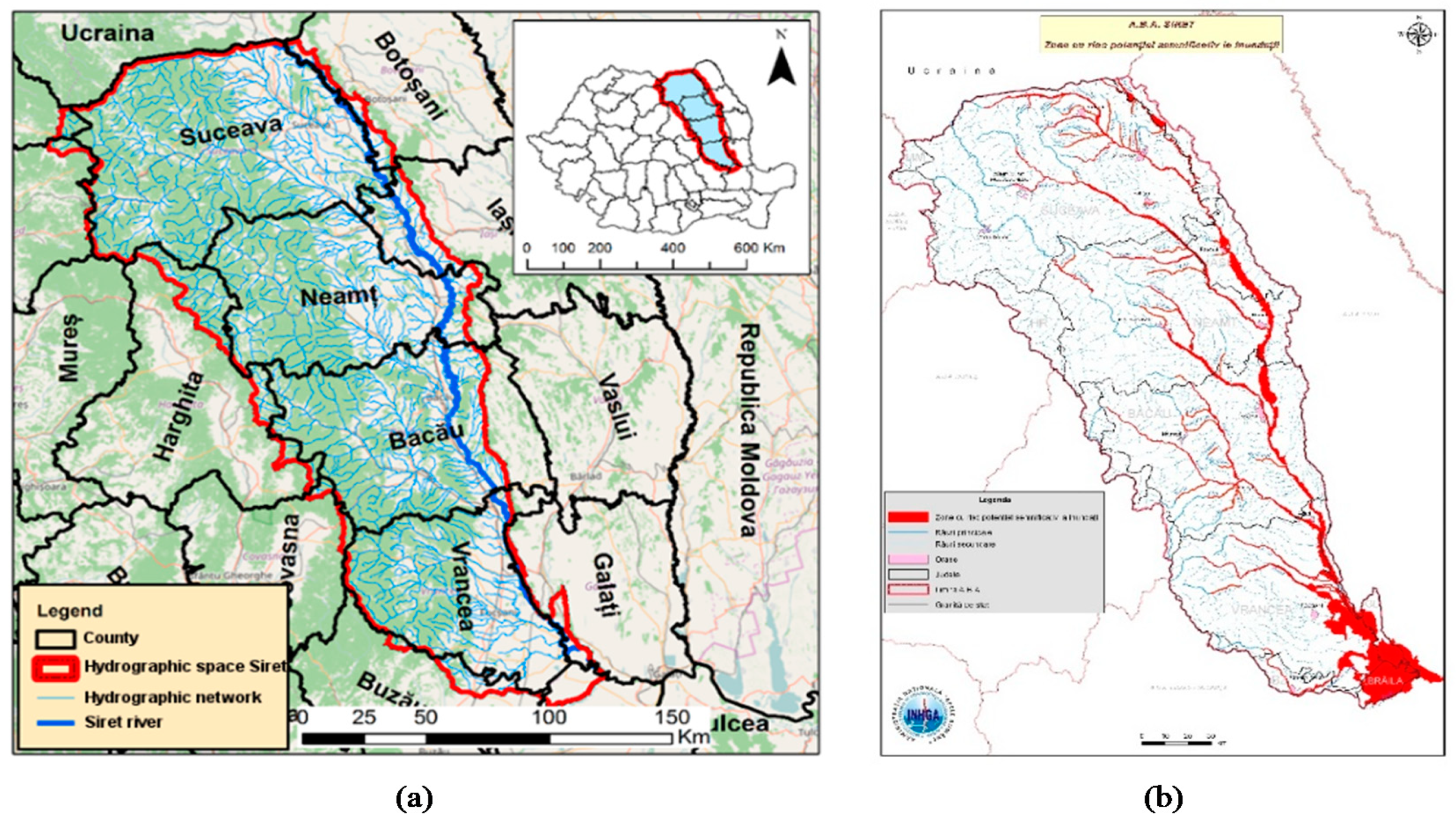







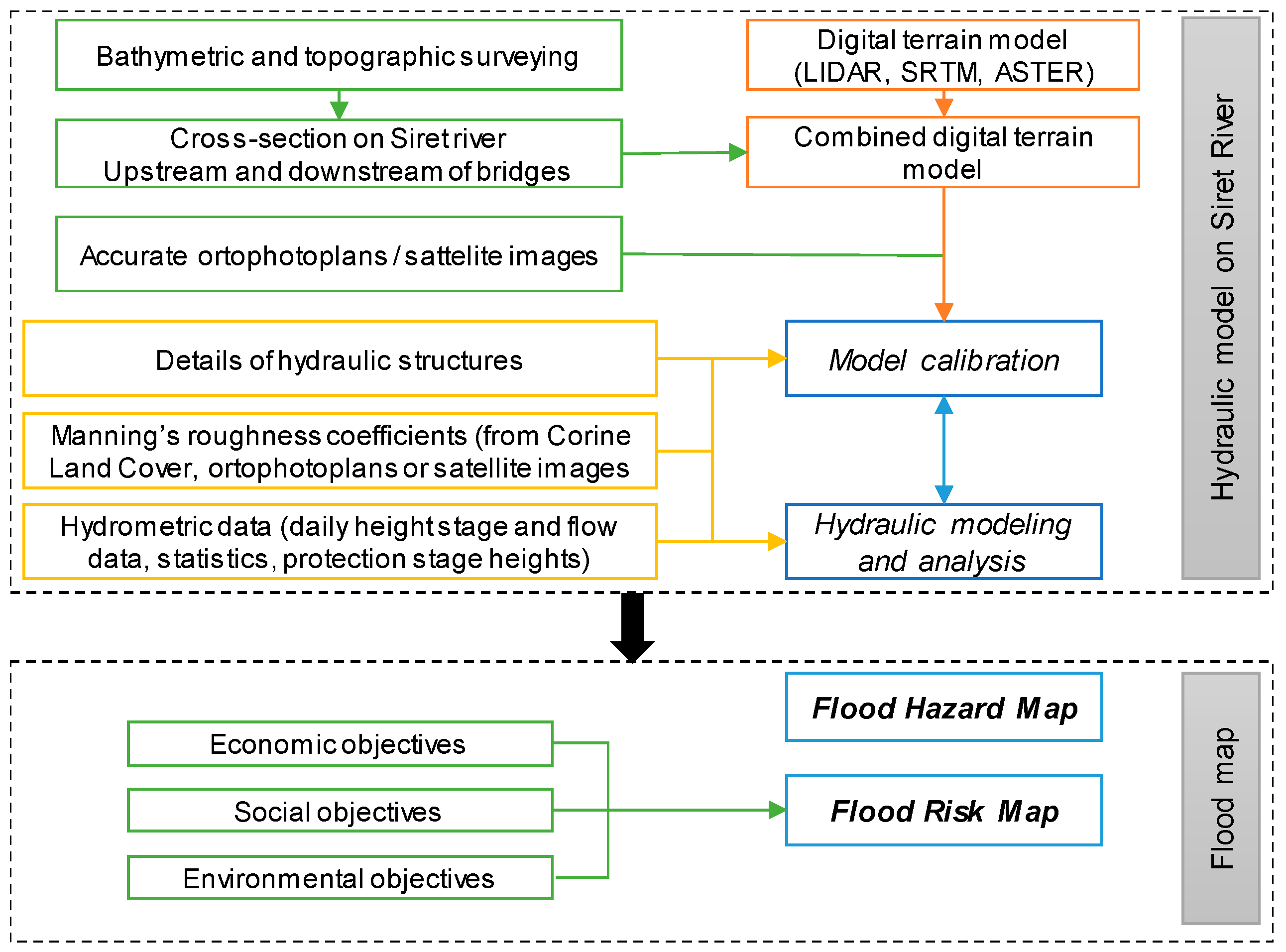
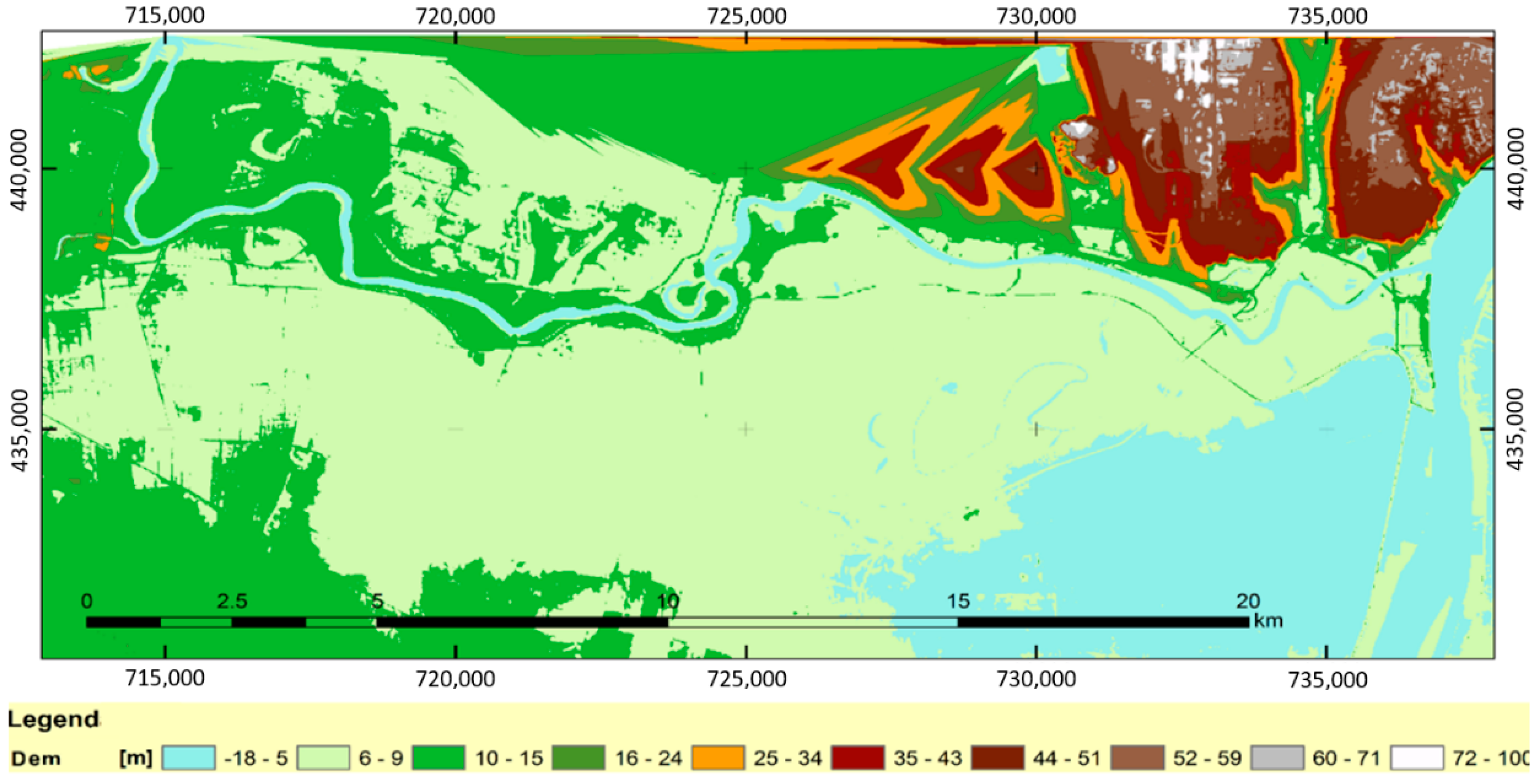
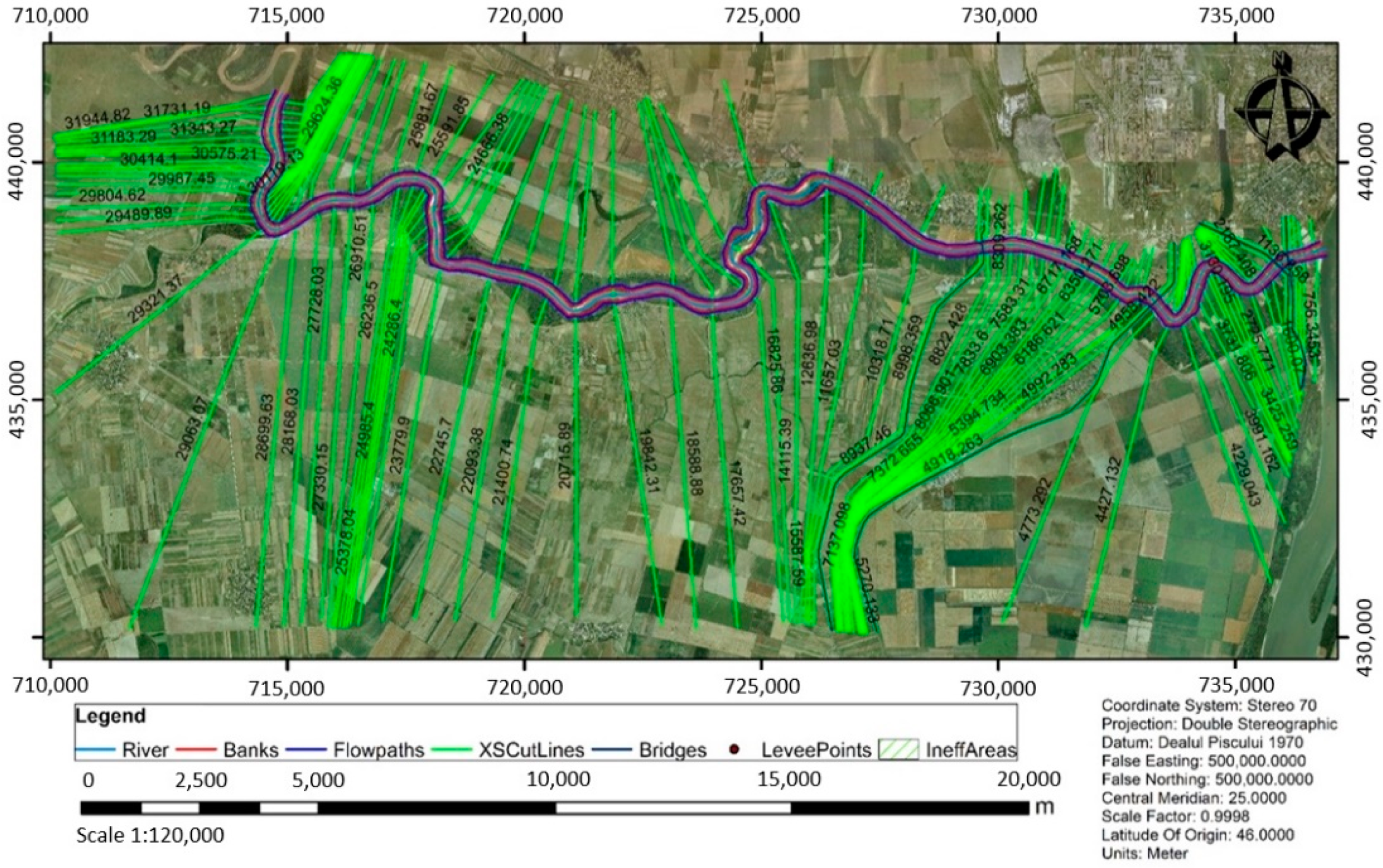
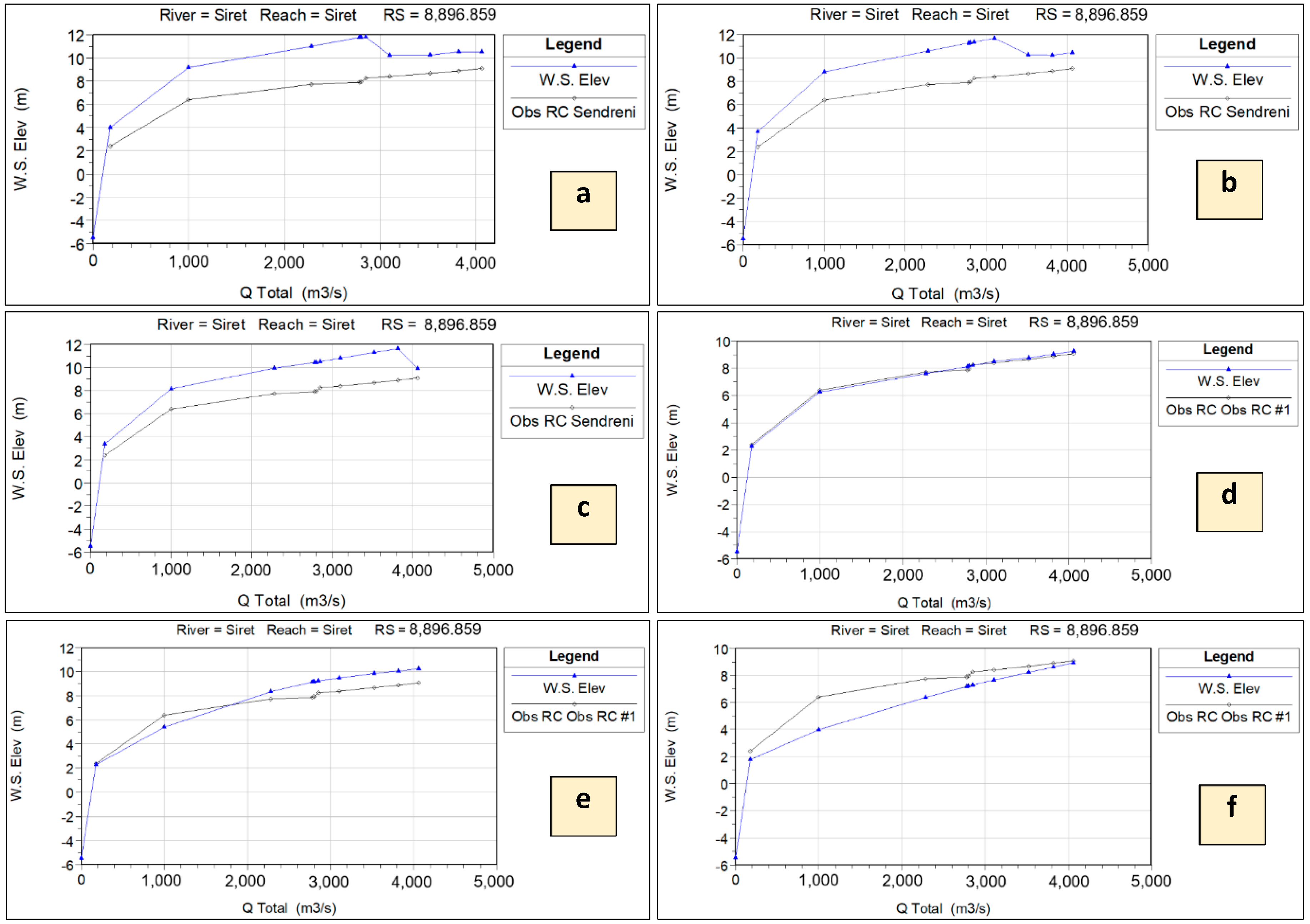
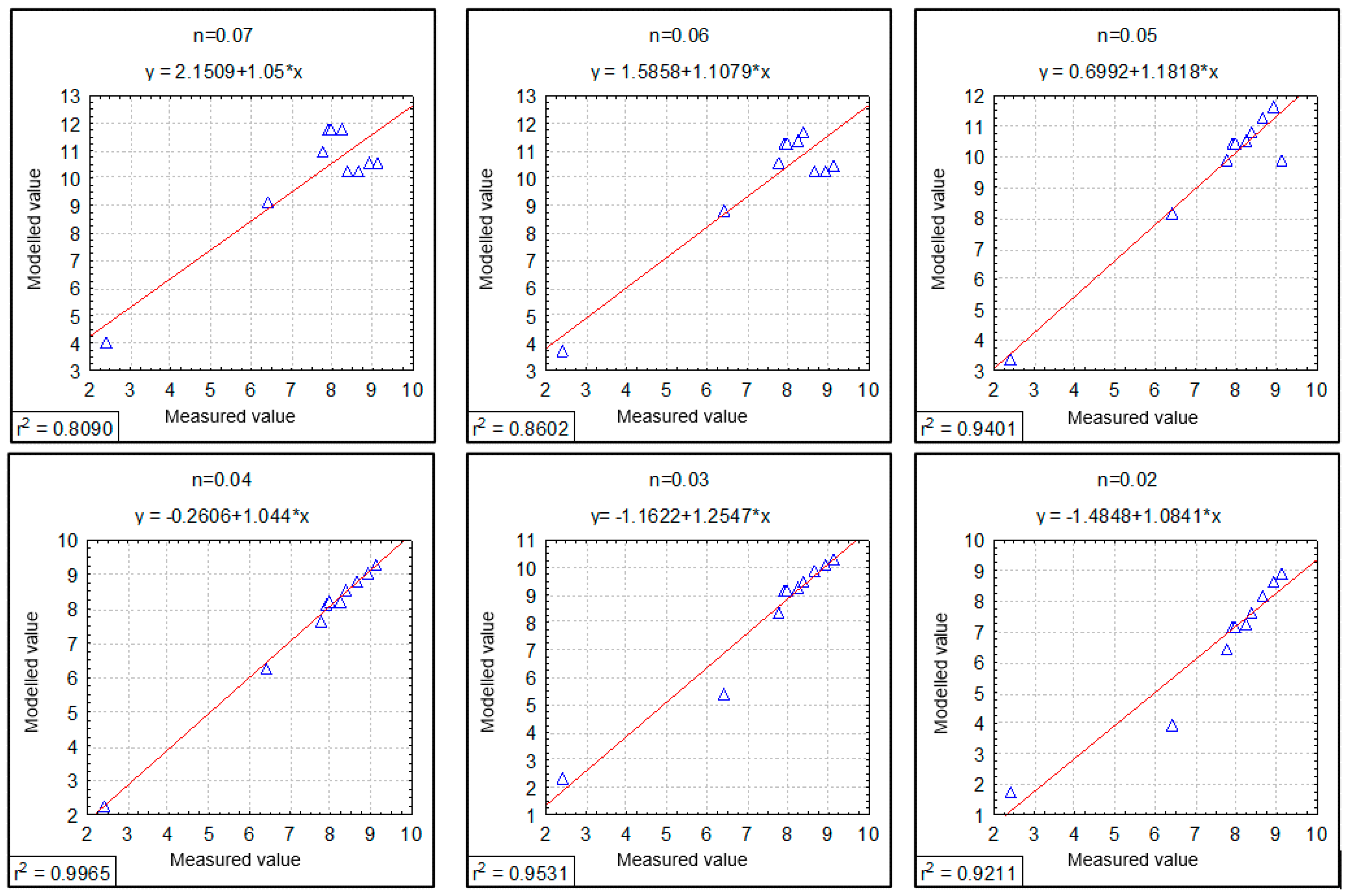
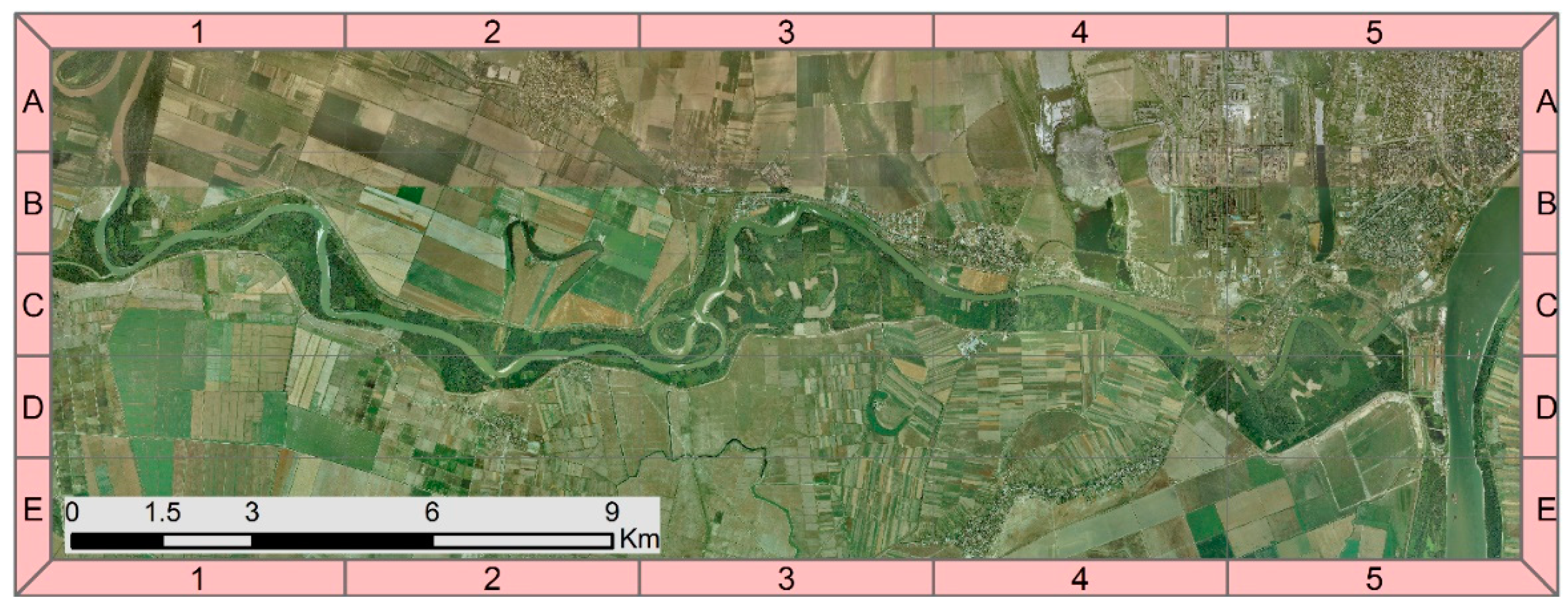
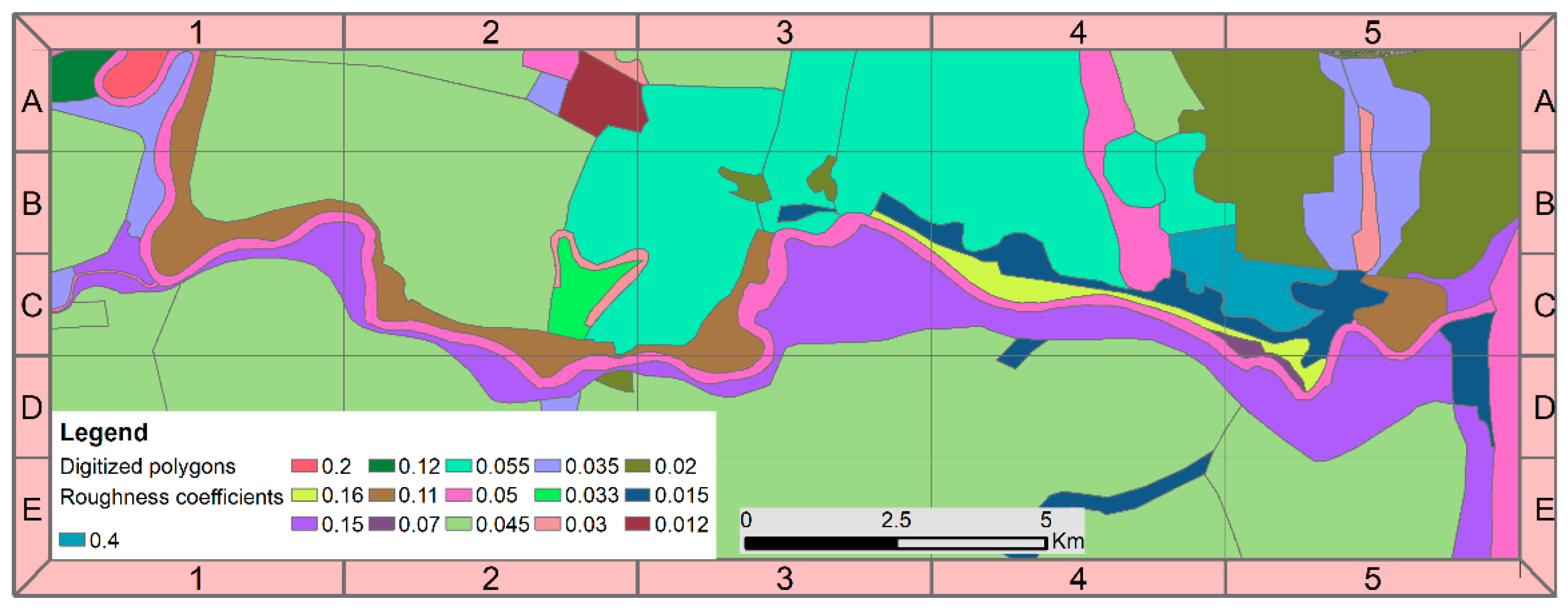
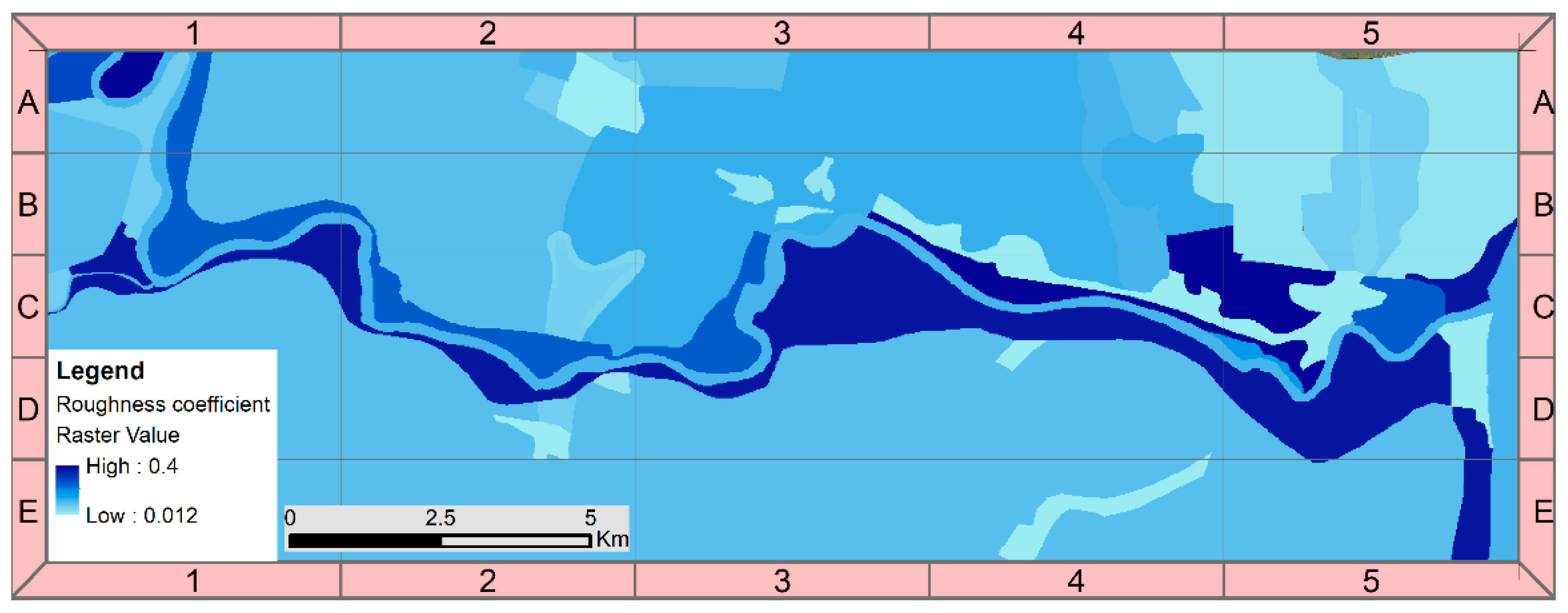

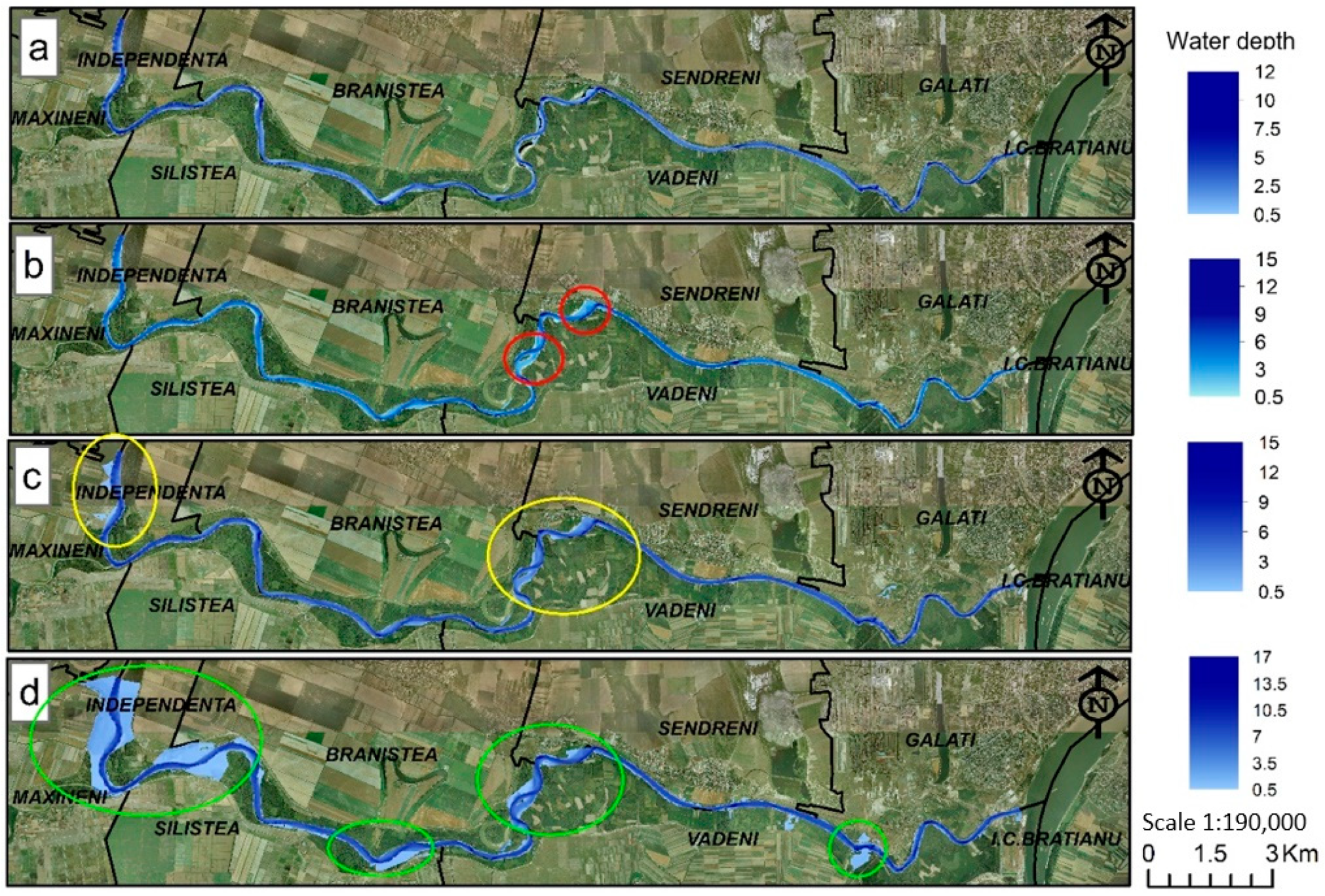
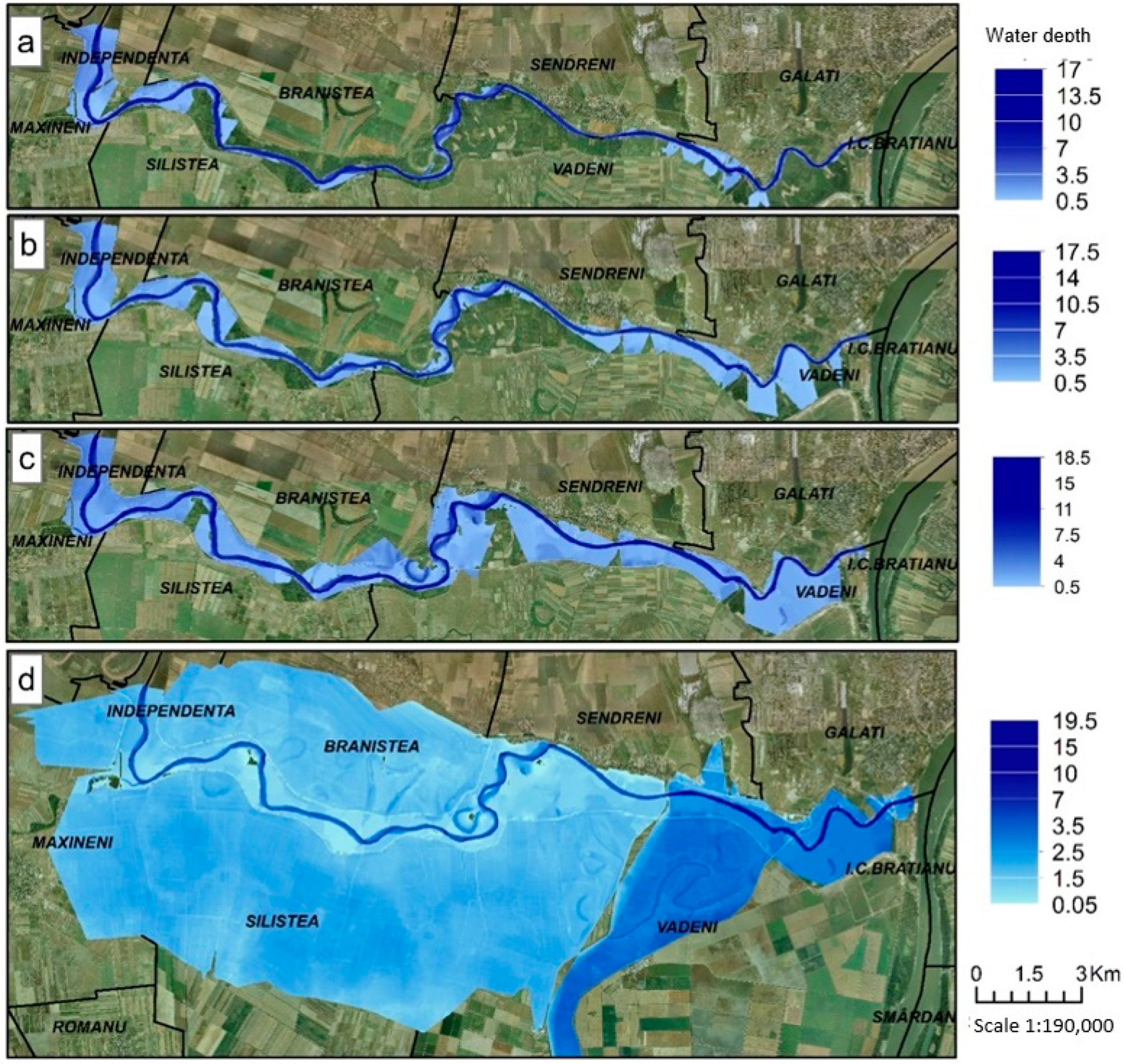
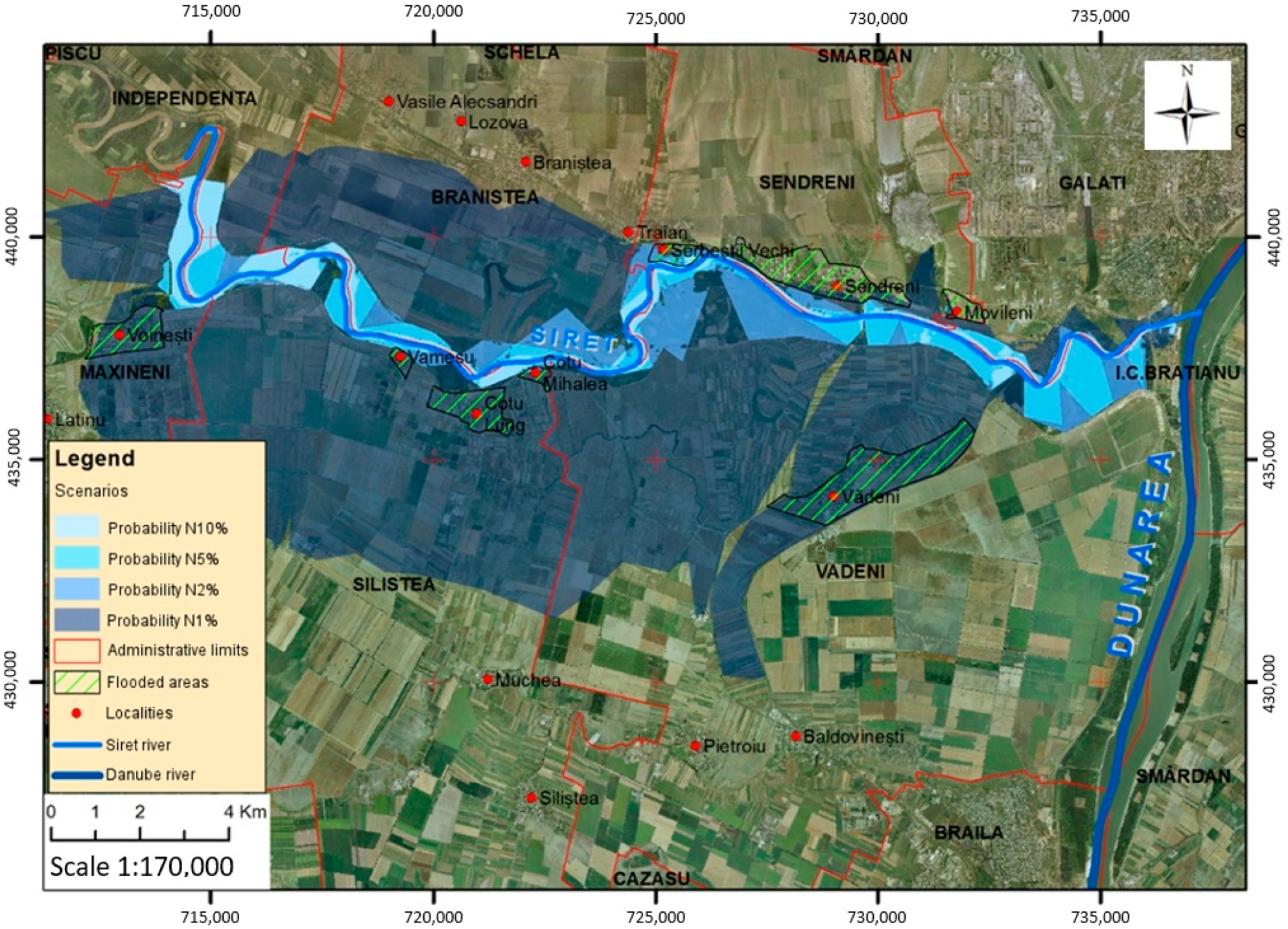
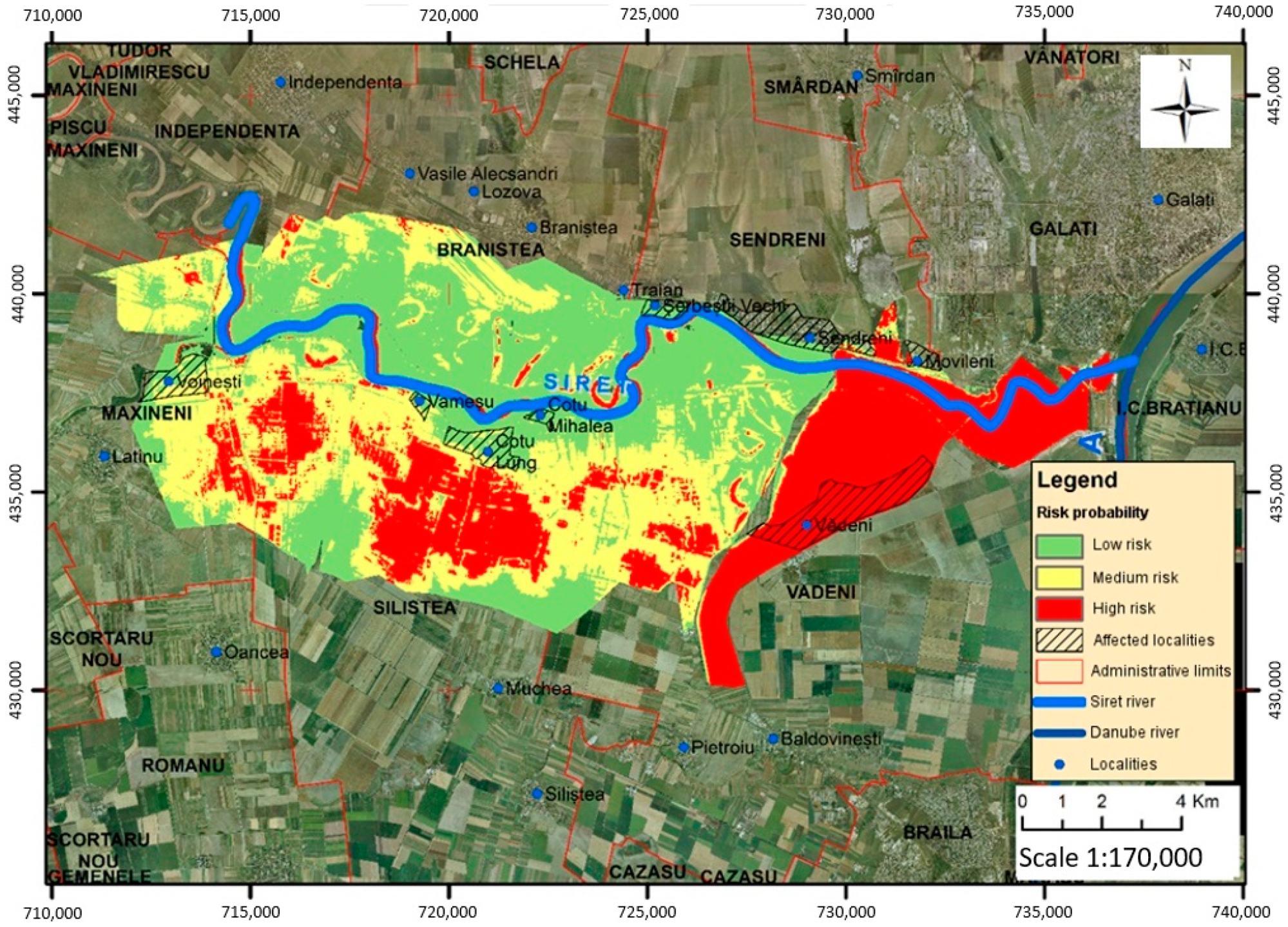
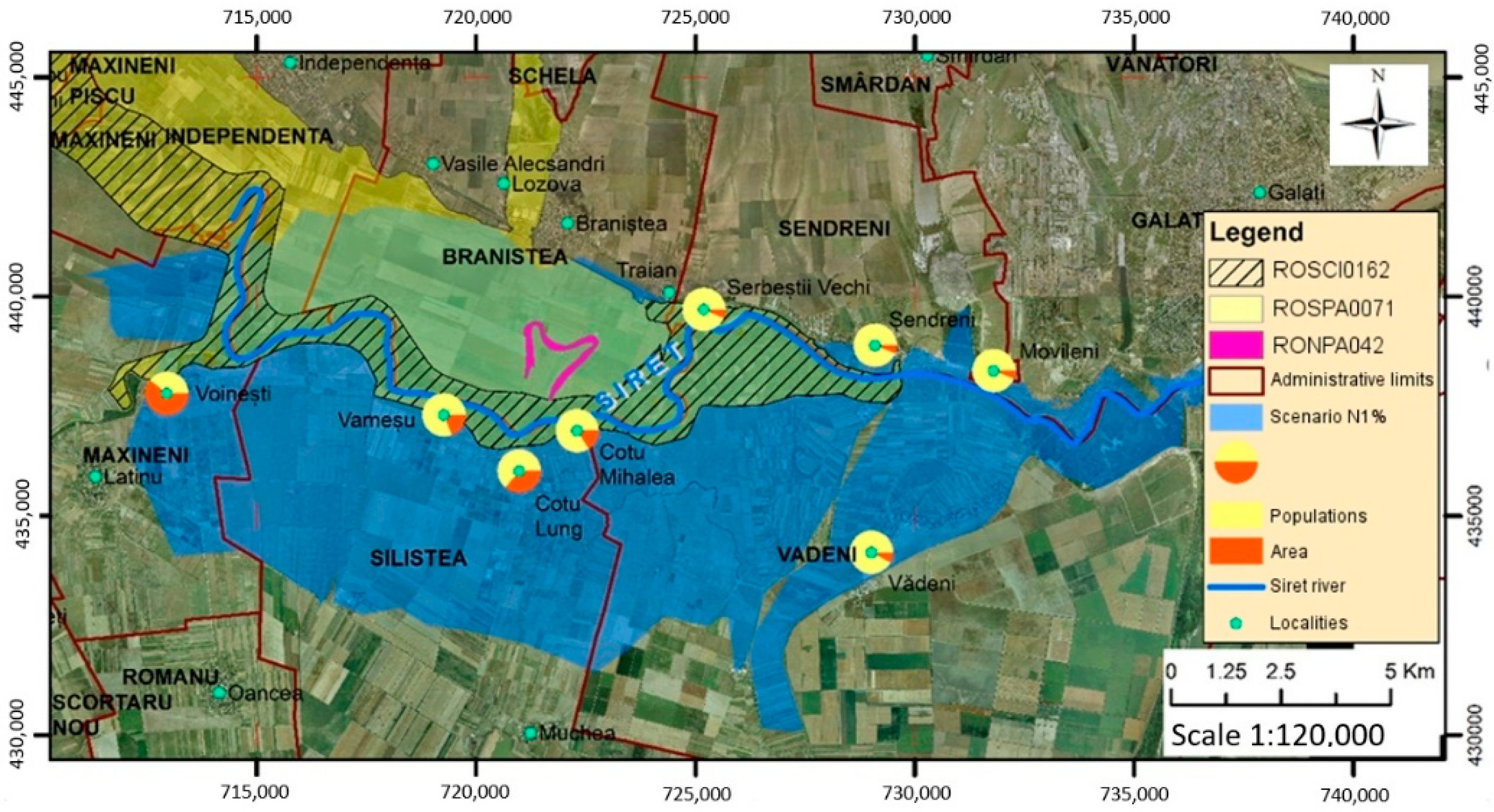
| Category | Description | Min | Normal | Max |
|---|---|---|---|---|
| Major riverbed | ||||
| Grassland | 0.030 | 0.035 | 0.050 | |
| Short grass | 0.035 | 0.040 | 0.045 | |
| Arable land | 0.033 | 0.045 | 0.055 | |
| Brushwood | 0.070 | 0.110 | 0.160 | |
| Thick trees, knobs, broken branches | 0.080 | 0.120 | 0.140 | |
| Broadleaf trees, willows, thick leaves during the summer | 0.110 | 0.150 | 0.200 | |
| Urban area | ||||
| Asphalt, pavement | 0.012 | 0.015 | 0.020 |
| Scenarios | 1 | 2 | 3 | 4 | 5 | 6 | 7 | 8 | |
|---|---|---|---|---|---|---|---|---|---|
| Boundary | |||||||||
| Qupstream | 500 | 1000 | 1500 | 2280 | 2500 | 2850 | 3520 | 4060 | |
| Sdownstream | 0.015 | 0.015 | 0.015 | 0.015 | 0.015 | 0.015 | 0.015 | 0.015 | |
| nmainchannel | 0.04 | 0.04 | 0.04 | 0.04 | 0.04 | 0.04 | 0.04 | 0.04 | |
| N% | - | - | - | N10% | - | N5% | N2% | N1% | |
© 2020 by the authors. Licensee MDPI, Basel, Switzerland. This article is an open access article distributed under the terms and conditions of the Creative Commons Attribution (CC BY) license (http://creativecommons.org/licenses/by/4.0/).
Share and Cite
Arseni, M.; Rosu, A.; Calmuc, M.; Calmuc, V.A.; Iticescu, C.; Georgescu, L.P. Development of Flood Risk and Hazard Maps for the Lower Course of the Siret River, Romania. Sustainability 2020, 12, 6588. https://doi.org/10.3390/su12166588
Arseni M, Rosu A, Calmuc M, Calmuc VA, Iticescu C, Georgescu LP. Development of Flood Risk and Hazard Maps for the Lower Course of the Siret River, Romania. Sustainability. 2020; 12(16):6588. https://doi.org/10.3390/su12166588
Chicago/Turabian StyleArseni, Maxim, Adrian Rosu, Madalina Calmuc, Valentina Andreea Calmuc, Catalina Iticescu, and Lucian Puiu Georgescu. 2020. "Development of Flood Risk and Hazard Maps for the Lower Course of the Siret River, Romania" Sustainability 12, no. 16: 6588. https://doi.org/10.3390/su12166588
APA StyleArseni, M., Rosu, A., Calmuc, M., Calmuc, V. A., Iticescu, C., & Georgescu, L. P. (2020). Development of Flood Risk and Hazard Maps for the Lower Course of the Siret River, Romania. Sustainability, 12(16), 6588. https://doi.org/10.3390/su12166588




